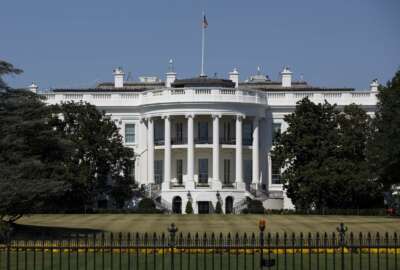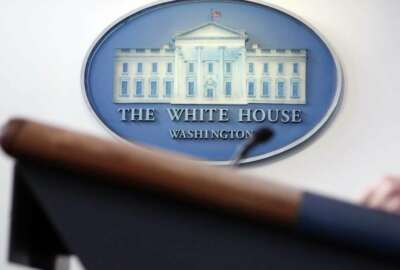
A federal employee’s guide to Trump and Biden’s 2020 campaign platforms
Federal News Network reviewed the track records and campaign policies for President Donald Trump and former Vice President Joe Biden. Here's where they stand on...
Update: This election guide was written prior to the release of President Trump’s executive order creating a new political corps within the civil service. Our story on that can be found here.
As federal employees know all too well, a presidential election can bring new changes to their pay, benefits and other topics important to their lives at the office, or as is still often the case in 2020, the home office.
While neither candidate has a plan solely on federal employees and the issues unique to them, Federal News Network reviewed the track records for President Donald Trump and former Vice President Joe Biden, as well as their campaign platforms online.
The Biden campaign has nearly 50 different plans for the economy, education and numerous other topics on its website.
The site for Trump’s reelection campaign is more spare. The president posted his reelection agenda in August, which lists nearly 50 short bullet points on his vision for the next four years. His “promises kept” page describes the actions he has taken so far during his first term.
Federal News Network has picked apart each candidate’s platforms in search for their stances on federal employee issues. Here are seven topics important to federal employees and contractors and where Trump and Biden stand on each of them.
Pay
As any federal employee knows, pay raises aren’t guaranteed. The president has the power to set federal pay raises (or freezes) during any given year, and Congress has the power — as it did twice during the Trump administration — to change course.
The National Active and Retired Federal Employees (NARFE) Association asked both candidates a series of questions about federal pay and benefits.
When asked about federal pay, Biden said: “I commit to consistent and regular pay increases necessary to ensure federal salaries remain competitive and that federal employees can support their families.”
Federal employees experienced three consecutive years of pay freezes during the Obama-Biden administration, with raises ticking up slightly during the later years.
The Trump campaign told NARFE it wasn’t participating in questionnaires this election cycle, so it didn’t provide a stance on federal pay and benefits for the next four years. The Trump campaign website is also silent on the topic.
Pay raises have been all over the map during the Trump administration. Trump has twice proposed federal pay freezes, only to reverse course later on in the year or have Congress pass higher raises into law. Federal employees earned their highest pay raise in a decade in 2020, with Congress writing a 3.1% bump into law late last year.
But that contradicts the narrative the administration has pushed over the last four years. In its own budget requests and pay proposals, the administration has described its vision of rewarding only the highest performing federal employees or those with critical skillsets with raises and other bonuses, rather than implementing an across-the-board pay adjustment for all.
Expect the Trump administration to continue that narrative if the president wins a second term.
Retirement and other benefits
Policy-wise, little has changed for federal retirees under the Trump administration, despite the president proposing several familiar changes to the current retirement system in his budget proposals.
Those proposals include:
- An increase in federal employee contributions to the Federal Employee Retirement System,
- An elimination of the cost-of-living adjustment for federal retirees,
- Basing future retirement benefits on the average of an employee’s highest five years of salary instead of an employee’s highest three years of salary, and,
- An elimination of the FERS Special Retirement Supplement payments for employees who retire before age 62.
No doubt, these proposals were active during the Obama-Biden administration as well. Congress under the Obama administration was responsible for increasing employee retirement contributions for new federal workers hired in 2013 and after 2014. The retirement changes were seen as a budget-cutting measure during the sequestration era.
As for Biden’s own plans for federal retirees? “I will oppose any proposal that retroactively changes federal retirement commitments,” Biden said in response to NARFE. “I will reject calls to increase contributions, lower benefits or reduce COLAs. And I will work to eliminate penalties like the Government Pension Offset and the Windfall Elimination Provision.”
On the Thrift Savings Plan, Biden simply said he would “strengthen it.”
As for other benefits for federal employees, Congress under the Trump administration was responsible for securing 12 weeks of paid parental leave for federal employees.
House Democrats, who had been pushing for a paid parental leave program for more than a decade, initially wanted to extend the benefit to federal employees who needed medical leave as well. But the final bill only included paid parental leave.
Biden, however, said he would expand the program to include paid medical leave for public and private sector workers.
Unions
New presidents often spend their first day in office repealing executive orders from the previous administration. If elected, expect a similar move from former Vice President Joe Biden. And expect Trump’s 2018 executive orders on collective bargaining, official time and employees to make that list.
“On Biden’s first day in office, he will restore federal employees’ rights to organize and bargain collectively and will direct his agencies to bargain with federal employee unions over non-mandatory subjects of bargaining,” according to Biden’s campaign platform.
Unions are counting on it. In announcing his endorsement over the summer, Tony Reardon, national president of the National Treasury Employees Union, said Biden told him personally he’d repeal the 2018 workforce EOs.

Labor-management relationships won’t turn rosy overnight. Some agencies and their unions have formed especially contentious relationships over the last four years, and it’ll take time for the ice to thaw. Some unions are locked into multi-year collective bargaining agreements with their agencies, and many of those provisions will carry into the next administration.
The Biden campaign has an extensive plan aimed at strengthening unions, with tougher penalties in place for corporations and other companies that fail to bargain in good faith and protections for public and private sector employees to organize. The former vice president also wants to form a cabinet-level working group, which would focus on increasing “union density” and economic equality, according to Biden’s website.
Even if many of Biden’s new initiatives are more focused on an expansion of collective bargaining in the private sector and in state and local governments, the tone on employee unions in the federal sector will likely change as well.
As for Trump, one of his signature policy changes for the federal workforce came in the form of those three executive orders, which he issued back in May 2018. The EOs were designed to shorten the collective bargaining process, cut back on official time and make it easier to fire poor performing federal employees.
Court battles over the president’s EOs lasted a year and delayed implementation of Trump’s orders. But the EOs are in full swing at most agencies today. Some agencies, including the Department of Veterans Affairs, have asked unions to vacate government-owned office space or begin paying rent.
With official time limited, some unions have hired outside help or turned to retired labor officials to help with the representational duties previously accomplished during work hours.
The Trump administration has found other ways to restrict the utility of federal employee unions.
The Federal Labor Relations Authority still lacks a general counsel — and enforcement authority — to prosecute agencies for breaking labor law. And at the request of agencies, the FLRA has implemented new rules that allow dues-paying federal employees to cancel automatic payments to their unions at any time, instead of the once-annual opportunity they had previously.
Diversity and inclusion
Biden and Trump offer starkly different approaches to diversity and inclusion in the federal government.
Diversity and inclusion initiatives are embedded within several Biden campaign platforms, including his plans for the economy, small businesses and others.

According to his campaign website, a Biden administration will reissue a 2011 executive order to promote diversity and inclusion in the federal workforce.
“He will modify it to mandate that cabinet agencies and other executive branch agencies work with federal employee unions to create and implement a diversity and inclusion plan for the federal workforce,” the Biden campaign platform reads. “And he will provide more training and mentoring opportunities to improve retention, and collect better data about who is applying for federal service positions as well as being promoted.”
A Biden administration is also interested in promoting more diverse leadership within the Federal Trade Commission, the Federal Deposit and Insurance Corporation, the Securities and Exchange Commission and other financial regulatory agencies.
“The leaders of federal agencies make decisions that have a direct impact on the nature of our entire economic system. At present the leadership of those agencies do not reflect the diversity of our country,” Biden’s campaign platform reads.
A Biden administration would also work with all three branches of government, including the Senate and Supreme Court, to create best practices for ensuring racial diversity among clerks, congressional staffers and interns. His administration would also create a new position on the White House Council of Economic Advisers that would focus on racial equity and income and wealth gaps, according to Biden’s website.
And finally, Biden said he would work with civil rights leaders to create implicit bias training for the federal employees and contractors to address discrimination based on race, sex, sexual orientation, gender identity and disability.
“He will promote flexible work arrangements both in government and in the private sector, including for people with disabilities, employees with a serious health condition, and older workers, as well as caregivers,” Biden’s plan reads.
The Trump administration, in contrast, had been mostly quiet on governmentwide diversity and inclusion initiatives until recently, when the White House issued an executive order banning certain kinds of training for federal agencies and contractors.
The order prohibits all training the administration deems as “divisive.” Federal employees who approve or advance training that promotes one of these divisive concepts may be subject to disciplinary action, while federal contractors that implement such training may be debarred.
All diversity and inclusion training is effectively on hold while the Office of Personnel Management reviews agency programs and materials, and it’s up to each agency to appoint a political appointee to oversee implementation of the EO.
The EO followed a memo from the Office of Management and Budget, which referred to critical race theory training as “anti-American propaganda.” The memo and the order itself have become flashpoints in recent presidential debates.
And while a Biden administration would prioritize implicit bias training for federal employees and contractors, the Trump administration named “unconscious bias” as one the keywords agencies should search for when surveying programs to potentially eliminate.
Government oversight and accountability
On his campaign website, Trump cited his five-year lobbying ban and a lifetime ban on lobbying for foreign countries for federal employees
Trump has fired about a handful of longtime inspectors general at several agencies, including the State Department, Department of Health and Human Services, and intelligence community. He also fired Glenn Fine, the deputy Defense IG and leader of the Pandemic Response Accountability Committee.
On his campaign website, Trump touted the success of his government reorganization plan, which he said several agencies were implementing. The reorganization plan, released in mid-2018, came after an executive order and subsequent guidance from the Office of Management and Budget asked agencies to prepare proposals and ideas.
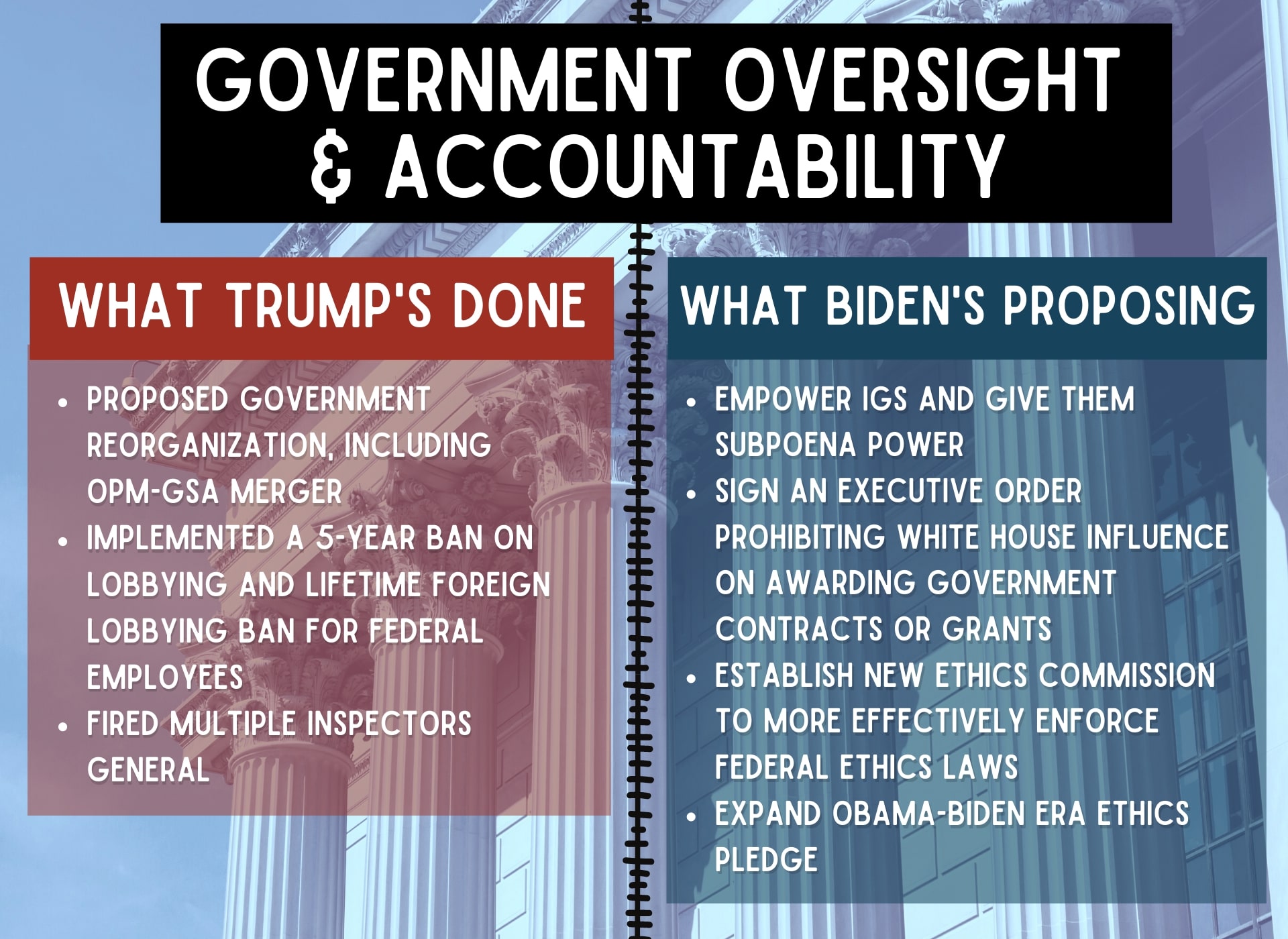
The reorganization included a few high-profile mergers of several cabinet agencies that never gained much momentum on Capitol Hill. Most notably for federal employees, the plan proposed merging the Office of Personnel Management with the General Services Administration.
The plan never picked up real bipartisan support, and it’s technically on hold following a congressionally-mandated review of OPM and its statutory functions. Still, the administration has quietly rearranged small offices within OPM and many longtime career executives have retired or left for other federal agencies.
The Trump administration did accomplish the transfer of OPM’s governmentwide security clearance business to the Pentagon, a move that agency and oversight officials say went reasonably well.
According to Biden’s plan, he will pass new laws designed to empower inspectors general and give them subpoena power.
He also proposed a new commission to more effectively police federal ethics laws. The group, called the Commission on Federal Ethics, would oversee and enforce anti-corruption and ethics law.
The commission would have investigative and enforcement authority, an expansion of the powers currently held by the Office of Special Counsel, Office of Government Ethics and Federal Election Commission. It would also create “Ethics.gov,” which Biden described as a “one-stop shop” where members of the public could learn about current ethics policies.
Finally, the commission would be charged with overseeing and implementing an executive order designed to prevent undue White House influence.
“Biden will ensure that agency decisions on specific matters, like awarding government contracts or granting government permits, are based on merit and expertise, not on political preferences,” his campaign platform reads. “Biden will issue an executive order prohibiting anyone in the White House from interfering with federal agencies on these matters, and he will require the White House to disclose to the public if any corporation, individual or other entity tries to solicit White House help.”
Federal contracting priorities
A regulation rollback perhaps best defines the Trump administration’s policies for small businesses and federal contractors. The president issued an executive order in the early days of his administration calling on agencies to cut two outdated regulations for every new rule they proposed.
The Small Business Administration finalized rules to improve the HUBZone program, to change the way the government calculates small business sizes based on earnings and a half dozen other rules that have been in the works since the 2015.
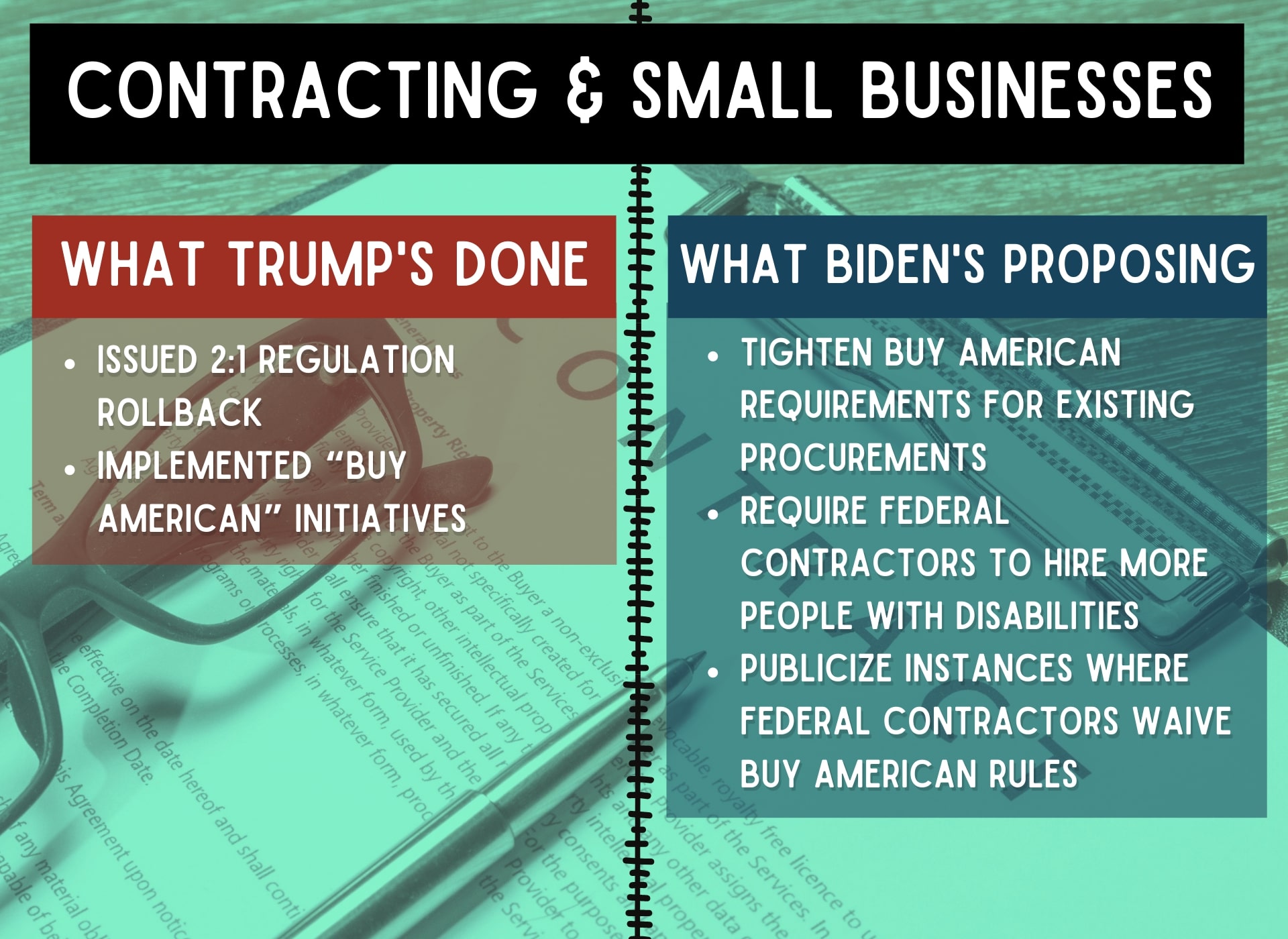
In addition, many federal agencies met or exceeded their goals for women-owned small business goals for the first time during the Trump administration.
Many of Biden’s federal contracting policies center on enhancing diversity and inclusion initiatives for federal contractors, a stark difference to the current administration’s recent plans.
Biden also plans to restrict federal contractors from contributing to the campaigns for federal candidates.
“If you make money from government contracts, you should do so on merit — not because of campaign spending,” Biden’s campaign site reads.
In addition, Biden wants to close a loophole that allows federal contractors to waive Buy American rules without explanation.
“He will establish a transparent process so that any time a federal contractor requests a waiver based on a claim that something can’t be made in America, it will be published on a website for all potential bidders and relevant stakeholders (like labor unions) to see,” Biden’s website reads.
Veterans
The Trump administration has enjoyed bipartisan focus and attention on veterans issues over the last four years, and as a result, it’s managed to achieve quite a few new, sweeping initiatives.
New legislation, all signed into law during the Trump presidency, have streamlined the disability appeals process, modernized the GI bill for new servicemembers and expanded benefits for caregivers and their families.
The Department of Veterans Affairs has drastically expanded telehealth services over the last four years, with the coronavirus pandemic responsible for a 1,000% increase in virtual appointments since mid-March.
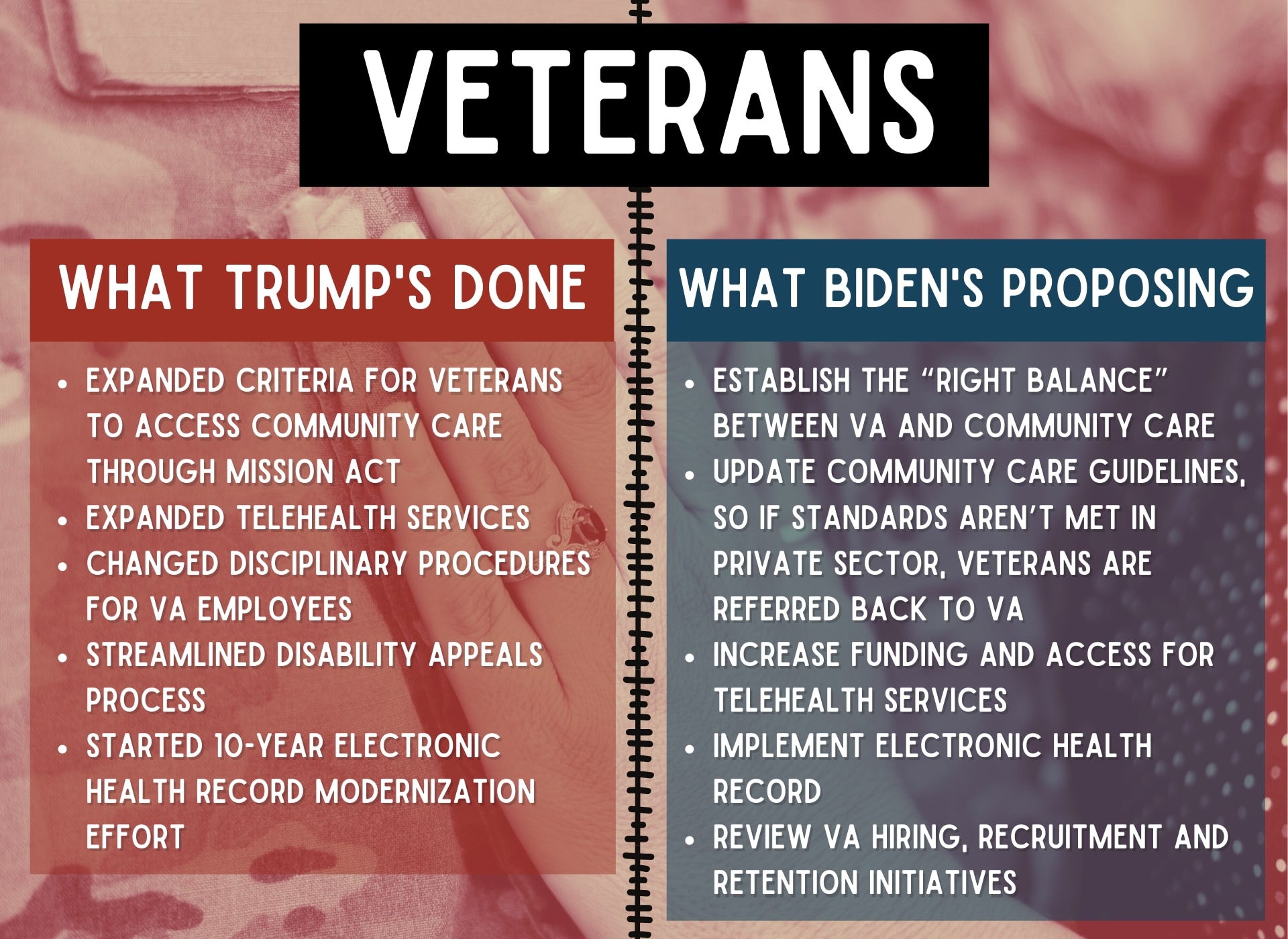
In recent years, VA began a 10-year, $16 billion effort to adopt a new, commercial electronic health record. The Defense Department and Coast Guard are deploying a similar system based on the same commercial platform, with the long-term goal of achieving interoperability between the VA and military health networks.
The VA Accountability and Whistleblower Protection Act, which Congress passed in 2017, has prompted far more debates. On the “promises kept” section of his campaign site, Trump said the law allowed his administration to fire or discipline roughly 4,300 VA employees since 2018, but data suggests the vast majority of those actions occur among lower-level workers, not among senior leaders and decision-makers.
VA’s still-new Office of Accountability and Whistleblower Protection has recommended discipline for seven senior leaders in an 18-month period, and employees have said the law has created unfair performance expectations with limited opportunities to improve.
In many ways, a Biden administration would pick up on many of the initiatives started under the Trump presidency.
According to his campaign, a Biden administration would implement the new EHR and make Blue Button easier to use.
Biden also said he will review VA staffing needs and recommend specific hiring, recruitment and retention initiatives to address vacancies in the department. The pandemic has prompted VA to cut steps out of its hiring processes, and as a result, the department is onboarding more medical professionals more quickly.
But the two campaigns perhaps differ most in their approach to community care.
Under the VA MISSION Act, the Trump administration expanded the criteria for which veterans are eligible to receive health care in the private sector and consolidated seven disparate community care programs into one. The law essentially revised the VA Choice program born under the Obama-Biden administration.
Democrats have been deeply skeptical of community care programs during both the Trump and Obama administrations, describing them as a backdoor effort to privatize the VA.
A Biden administration, however, doesn’t plan to eliminate those community care programs. Instead, his administration would “build on” the MISSION Act and “establish the right balance of VA care and purchased care, region by region, based on veteran needs, existing VA capacity, and availability of market alternatives,” according to Biden’s veterans platform.
In addition, Biden said he would create a “full circle” referral process, so if veterans weren’t receiving care quickly enough in the private sector, they’d go back to the VA. Currently, VA doesn’t have specific wait-time standards for its private sector providers part of the community care program.
Story graphics by Amelia Brust, Federal News Network
Copyright © 2024 Federal News Network. All rights reserved. This website is not intended for users located within the European Economic Area.
Nicole Ogrysko is a reporter for Federal News Network focusing on the federal workforce and federal pay and benefits.
Follow @nogryskoWFED
Related Stories
